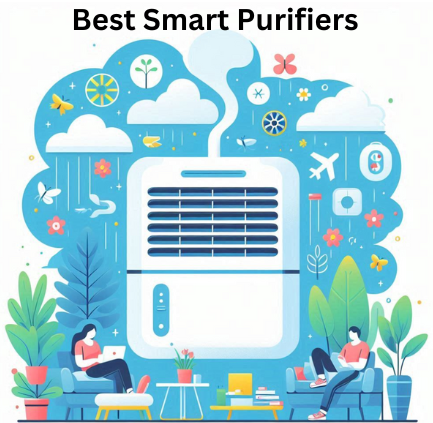
The Growing Need for Air Purification
Indoor air quality has never been more important. As urbanization expands and pollution levels rise, people are spending more time indoors, whether at home or in offices. However, the air inside is often far from pure. Studies by the Environmental Protection Agency (EPA) have shown that indoor air can be up to five times more polluted than outdoor air. Dust, pet dander, volatile organic compounds (VOCs) from household products, and microscopic allergens all contribute to an invisible yet significant health threat. For individuals with respiratory issues such as asthma or allergies, these airborne contaminants can trigger serious discomfort or illness. Even for those without pre-existing conditions, prolonged exposure to indoor air pollutants has been linked to fatigue, headaches, and decreased cognitive function.
Historically, people have relied on basic methods to manage air quality, from opening windows to using fans and charcoal-based air fresheners. The earliest attempts at air purification date back to ancient civilizations. The Egyptians, for instance, used porous clay pots to filter water and, by extension, remove some airborne impurities when water evaporated. In 19th-century Europe, during the Industrial Revolution, scientists began developing rudimentary air filtration systems to protect workers from the harmful fumes produced by factories. By the mid-20th century, HEPA (High-Efficiency Particulate Air) filters were introduced, originally developed for military use to contain radioactive particles. These innovations laid the groundwork for the air purification technologies we rely on today.
What began as simple filtration systems has now evolved into smart air purifiers—devices that do more than just clean the air. The integration of artificial intelligence, real-time air quality monitoring, and voice control has transformed them into intuitive home companions. Unlike the bulky, noisy air purifiers of the past, today’s models blend into modern interiors with sleek designs, making them both functional and aesthetically appealing. This shift from mere necessity to stylish convenience has changed the way we think about indoor air purification, making it a seamless part of contemporary living.
The Evolution of Air Purification: From Basic Filtration to Smart Technology
The concept of air purification has developed alongside advances in technology and scientific understanding of airborne pollutants. The earliest air purifiers were passive, relying on simple filtration methods to trap particles. HEPA filters, which became commercially available in the 1950s, revolutionized air purification by capturing up to 99.97% of microscopic particles. However, these early models required frequent maintenance and lacked automation, meaning users had to manually adjust settings based on perceived air quality.
By the late 20th century, activated carbon filters were introduced to combat chemical pollutants such as cigarette smoke, household odors, and industrial fumes. This innovation allowed air purifiers to target a broader range of contaminants, but the fundamental challenge remained: how could consumers know when the air quality in their homes was compromised? Enter the era of smart air purification.
Modern smart air purifiers use built-in sensors to detect pollutants in real-time, automatically adjusting their filtration levels as needed. Brands like Dyson, Molekule, and Philips have pioneered sleek, technologically advanced models that not only purify the air but also integrate seamlessly into smart home ecosystems. These devices can be controlled via smartphone apps, offering users real-time air quality updates and the ability to customize settings remotely. Some models even respond to voice commands through assistants like Alexa and Google Home, allowing for effortless control.
This transition from traditional to smart air purifiers represents more than just technological advancement—it reflects a shift in consumer priorities. Today’s buyers seek products that combine efficiency, convenience, and aesthetics. Gone are the days when air purifiers were bulky, noisy machines relegated to the corners of rooms. Now, they are sophisticated lifestyle accessories designed to enhance both health and home decor.
The Science Behind Smart Air Purification
At the heart of every air purifier lies a sophisticated combination of filtration and airflow mechanics. Traditional purifiers rely primarily on mechanical filters such as HEPA and activated carbon, but smart air purifiers take things a step further by incorporating additional purification technologies.
One of the most significant advancements is real-time air quality monitoring. Built-in sensors analyze air composition and detect changes in pollutant levels, triggering automatic adjustments. For instance, if someone starts cooking in the kitchen, releasing smoke and grease particles into the air, a smart purifier can increase its fan speed to counteract the contamination. Similarly, during high pollen seasons, the device can proactively optimize filtration settings to reduce allergens in the home.
Some high-end models also employ ultraviolet (UV) light technology to neutralize airborne bacteria and viruses, offering an added layer of protection. Others use ionization, which releases negatively charged ions to bind with pollutants, making them easier to capture. While these advanced techniques improve efficiency, smart purifiers are designed with user convenience in mind. Features like WiFi connectivity, remote access via mobile apps, and integration with other smart devices ensure that air purification happens effortlessly in the background without constant manual intervention.
This level of automation not only enhances air quality but also aligns with the growing trend of smart home technology, where interconnected devices create a seamless living environment. The ability to monitor and control air quality remotely is particularly beneficial for individuals in urban areas, where pollution levels can fluctuate dramatically throughout the day.
Blending Technology with Aesthetics: A New Era of Air Purifiers
Beyond their advanced functionality, modern air purifiers are designed to complement contemporary home decor. Manufacturers understand that consumers no longer want a large, unattractive appliance disrupting their carefully curated interiors. Instead, sleek, minimalistic designs have taken center stage.
Dyson, for example, has redefined air purification with its bladeless, futuristic designs that double as cooling fans. Molekule, on the other hand, integrates its purifiers into cylindrical aluminum casings with leather straps, making them look more like high-end home accessories than traditional appliances. Other brands offer purifiers in various colors and finishes, allowing homeowners to choose models that blend with their interior themes—whether minimalist Scandinavian, industrial chic, or warm and rustic.
This emphasis on aesthetics is more than just a marketing strategy; it reflects the broader trend of functional home technology merging with interior design. Consumers are now looking for products that not only improve their quality of life but also enhance their living spaces. An air purifier that seamlessly integrates into its surroundings is more likely to be used consistently, ensuring long-term health benefits.

Selecting the Right Smart Air Purifier for Your Home
Choosing the right air purifier depends on several factors, including room size, pollutant concerns, and lifestyle preferences. Those who suffer from allergies or asthma should prioritize models with HEPA filters and real-time air monitoring, ensuring that allergens like pollen and pet dander are effectively removed. City dwellers exposed to traffic pollution and industrial emissions may benefit from purifiers with activated carbon filters, which absorb harmful gases and odors.
Beyond performance, the choice of purifier should align with the aesthetics of the home. Some prefer models that discreetly blend into the background, while others may opt for statement pieces that serve as conversation starters. Additionally, smart features such as app control, scheduling, and voice commands can enhance user experience, offering convenience for those who embrace smart home technology.
Budget considerations also play a role. While high-end models come with advanced sensors, multiple filtration layers, and design-forward aesthetics, there are also affordable options that provide essential air purification without unnecessary frills. By balancing functionality, design, and budget, consumers can find the ideal purifier to meet their needs.
The Future of Air Purification in Smart Homes
As air quality concerns continue to rise, smart air purifiers are set to become a staple in modern homes. Their integration with the Internet of Things (IoT), enhanced automation, and AI-driven optimizations will make indoor environments healthier and more responsive to real-time air conditions. Future innovations may include self-cleaning filters, even quieter operation, and increased energy efficiency.
What once seemed like a luxury is quickly becoming a necessity. Air purifiers are no longer just about cleaning the air—they are about enhancing lifestyles, merging seamlessly with home decor, and integrating into the broader ecosystem of smart living. With technology advancing at an unprecedented pace, the future of air purification promises not only cleaner air but smarter, healthier, and more aesthetically pleasing living spaces.
Breathe Easy: Replace Your Air Filter Easily Today. GO NOW: FiltersFast.com

